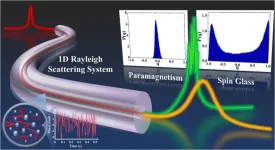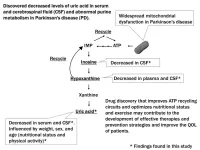(Press-News.org) In some mammals, the timing of the normally continuous embryonic development can be altered to improve the chances of survival for both the embryo and the mother. This mechanism to temporarily slow development, called embryonic diapause, often happens at the blastocyst stage, just before the embryo implants in the uterus. During diapause, the embryo remains free-floating and pregnancy is extended. This dormant state can be maintained for weeks or months before development is resumed, when conditions are favorable. Although not all mammals use this reproductive strategy, the ability to pause development can be triggered experimentally. Whether human cells can respond to diapause triggers remained an open question.
Now, a study by the labs of Aydan Bulut-Karslıoğlu at the Max Planck Institute for Molecular Genetics in Berlin and Nicolas Rivron at the Institute of Molecular Biotechnology (IMBA) of the Austrian Academy of Sciences in Vienna, an ERC grantee, has identified that the molecular mechanisms that control embryonic diapause also seem to be actionable in human cells. Their results were published on September 26th in the journal Cell.
Stem cell-derived models to study embryonic diapause in humans
In their research, the scientists did not carry out experiments on human embryos and instead used human stem cells and stem cell-based blastocyst models called blastoids. These blastoids are a scientific and ethical alternative to using embryos for research. The researchers discovered that modulation of a specific molecular cascade, the mTOR signaling pathway, in these stem cell models induces a dormant state remarkably akin to diapause. “The mTOR pathway is a major regulator of growth and developmental progression in mouse embryos”, says Aydan Bulut-Karslioglu. “When we treated human stem cells and blastoids with an mTOR inhibitor we observed a developmental delay, which means that human cells can deploy the molecular machinery to elicit a diapause-like response."
This dormant state is characterized by reduced cell division, slower development and a decreased ability to attach to the uterine lining. Importantly, the capacity to enter this dormant stage seems to be restricted to a brief developmental period. “The developmental timing of blastoids can be stretched around the blastocyst stage, which is exactly the stage where diapause works in most mammals”, says shared first author Dhanur P. Iyer. Moreover, this dormancy is reversible, and blastoids resume normal development when the mTOR pathway is reactivated.
The ability to alter the timing of embryonic development has implications for IVF
The authors concluded that humans, like other mammals, might possess an inherent mechanism to temporarily slow down their development, even though this mechanism may not be used during pregnancy. “This potential may be a vestige of the evolutionary process that we no longer make use of,” says Nicolas Rivron. “Although we have lost the ability to naturally enter dormancy, these experiments suggest that we have nevertheless retained this inner ability and could eventually unleash it.” For basic research, the question arises as to whether human and other mammalian cells enter the dormant state via similar or alternative pathways and use it for the same purposes, for example either pausing or timing their development and implantation.
The team’s discoveries could have implications for reproductive medicine: "On the one hand, undergoing faster development is known to increase the success rate of in vitro fertilization (IVF), and enhancing mTOR activity could achieve this," Nicolas Rivron explains. "On the other hand, triggering a dormant state during an IVF procedure could provide a larger time window to assess embryo health and to synchronize it with the mother for better implantation inside the uterus."
Overall, the new findings provide unforeseen insights into the processes governing our earliest development, which might open new avenues for enhancing reproductive health. “This exciting collaboration is a testimony to how complex biological questions can be tackled by bringing together respective expertise," says Heidar Heidari Khoei, postdoctoral fellow in the lab of Nicolas Rivron and the study’s co-first author. "I believe this work not only underscores the importance of collaboration in advancing science but also opens up further possibilities for understanding how various signals are perceived by cells as they prepare for their developmental journey.”
Nicolas Rivron is a group leader at IMBA and funded by an ERC Consolidator Grant.
END
Scientists discover "pause button" in human development
2024-09-26
ELSE PRESS RELEASES FROM THIS DATE:
Replica symmetry breaking in 1D Rayleigh scattering system: Theory and validations
2024-09-26
In both the natural world and human society, there commonly exist complex systems such as climate systems, ecological systems, and network systems. Due to the involvement of numerous interacting elements, complex systems can stay in multiple different states, and their overall behavior generally exhibits randomness and high disorder. For example, due to the complex interactions between factors such as solar radiation, terrain, and ocean currents, the climate system can exhibit various states like sunny, cloudy, and rainy. The dynamic changes and mutual influences of these factors make the behavior of the climate highly uncertain and difficult to predict accurately. For instance, the formation ...
New research identifies strong link between childhood opportunities and educational attainment and earnings as a young adult
2024-09-26
Washington, September 26, 2024—The number of educational opportunities that children accrue at home, in early education and care, at school, in afterschool programs, and in their communities as they grow up are strongly linked to their educational attainment and earnings in early adulthood, according to new research. The results indicate that the large opportunity gaps between low- and high-income households from birth through the end of high school largely explain differences in educational and income achievement ...
Statement by NIH on research misconduct findings
2024-09-26
EMBARGOED FOR RELEASE
Thursday, September 26, 2024 - 9 a.m. EDT
Contact:
NIH Office of Communications and Public Liaison
NIH News Media Branch
301-496-5787
Statement by NIH on Research Misconduct Findings
Following an investigation, the National Institutes of Health (NIH) has made findings of research misconduct against Eliezer Masliah, M.D., due to falsification and/or fabrication involving re-use and relabel of figure panels representing different experimental results in two publications. NIH will notify the two journals of its findings so that appropriate action can be taken. NIH initiated its research misconduct review process ...
Pregnant women who sleep less than 7 hours a night may have children with developmental delays
2024-09-26
WASHINGTON—Pregnant women who do not get enough sleep may be at higher risk of having children with neurodevelopmental delays, according to new research published in the Endocrine Society’s Journal of Clinical Endocrinology & Metabolism.
Short sleep duration (SSD) is defined as sleeping less than seven hours per night. Pregnant woman may have trouble sleeping due to hormonal changes, pregnancy discomfort, frequent urination, and other factors.
It’s been reported that almost 40% of pregnant women have SSD. These women may have ...
ESO telescope captures the most detailed infrared map ever of our Milky Way
2024-09-26
Astronomers have published a gigantic infrared map of the Milky Way containing more than 1.5 billion objects ― the most detailed one ever made. Using the European Southern Observatory’s VISTA telescope, the team monitored the central regions of our Galaxy over more than 13 years. At 500 terabytes of data, this is the largest observational project ever carried out with an ESO telescope.
“We made so many discoveries, we have changed the view of our Galaxy forever,” says Dante Minniti, ...
An edible toothpaste-based transistor
2024-09-26
Milan (Italy), 26 September 2024 - A toothpaste-based transistor is the latest innovation from the research team at the Istituto Italiano di Tecnologia (IIT-Italian Institute of Technology) in Milan, which pushes the boundaries of edible electronics. This innovative nano-device is expected to become a key component of future smart pills, designed to monitor health conditions from within the body and then safely dissolve after completing their function. The research findings have been published in the journal Advanced Science.
Several commercial toothpaste formulations contain crystals of copper phthalocyanine, a blue pigment that acts as a whitening ...
Increased antioxidants and phenolic compounds produced in salted red perilla leaves during Japanese apricot pickling
2024-09-26
The diverse biochemical composition of Japanese apricot fruits explains their broad spectrum of action on the human body. The high levels of key phenolic compounds and hydroxycinnamic acids contribute to various health benefits including anti-inflammatory, antioxidant, and antimicrobial properties.
A recent study published in Food Research International on July 19, 2024, led by Prof. Yukiharu Ogawa and Jutalak Suwannachot from Chiba University, quantitatively evaluated the changes in phenolic compounds and antioxidant activity during the production of Shiso-zuke Umeboshi (PP). The study also simulated the digestive process to characterize the release of these compounds and ...
Unlocking the energy crisis in Parkinson’s: New findings offer hope for future treatment
2024-09-26
Parkinson’s disease (PD), the second most common neurodegenerative disorder globally, has long baffled scientists with its progressive nature and debilitating effects on motor function.
A recent study from the School of Medicine at Fujita Health University has brought new insights into the metabolic disruptions experienced by patients with PD. By analyzing the blood and cerebrospinal fluid (CSF) of the patients, researchers have discovered critical impairments in purine metabolism and the recycling of adenosine triphosphate (ATP)—the molecule responsible for energy production in cells.
For years, scientists have noted the decreased levels ...
‘Weekend warrior’ physical activity may help protect against more than 200 diseases
2024-09-26
Busy with work and other obligations, some people concentrate their moderate-to-vigorous exercise in one or two days of the week or weekend. A study led by investigators at Massachusetts General Hospital, a founding member of the Mass General Brigham healthcare system, has found that this “weekend warrior” pattern of exercise is associated with lower risk of developing 264 future diseases and was just as effective at decreasing risk as more evenly distributed exercise activity. Results are published in Circulation.
“Physical activity is known to affect risk of many diseases,” said ...
People with unmedicated mental illness are less likely to be vaccinated against COVID-19
2024-09-26
Vaccination coverage for COVID-19 is high in both people with and without mental illness, according to a large multinational study led by researchers at Karolinska Institutet and published in Nature Communications. However, Swedish registry data revealed that individuals with unmedicated mental illness have lower vaccination levels.
The researchers analysed data from seven studies in five countries (Sweden, Norway, Iceland, Estonia, and Scotland) as part of the COVIDMENT consortium, totalling just over 325,000 individuals, and registry data from Sweden including over ...







